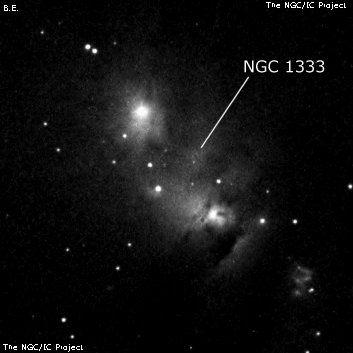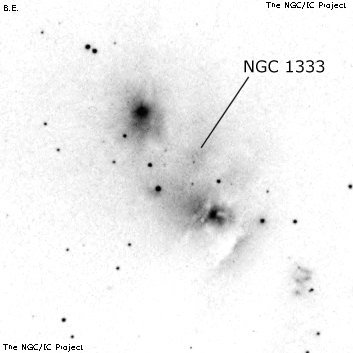NGC/IC Project Restoration Effort
(This is a very very beta version)
NGC1333


Basic Information
Location and Magnitude
Right Ascension: 3:29:18.0
Declination: +31:25:0
Constellation: PER
Visual Magnitude:
Historic Information
Discoverer: Schönfeld
Year of discovery: 1855
Discovery aperture: 3.0
Observational
Summary description: F, L, * 10 nf (Auw No 17)
Sub-type: RN
Corwin's Notes
=====
NGC 1333. Though there is no question about the identity of this nebula, its
early observations with small telescopes were contradictory enough to lead to
suggestions that it might be variable. The note in Auwers's 1862 appendix to
WH's catalogue makes it clear that Tuttle's observation of 1859 has the
directions of the field inverted. This probably contributed to the perception
of variability.
Interestingly, part of the object seems to be a collapsing protostar (see Sky
and Telescope, January 1997, pages 15 and 16 for the story). Is it thus
possible that N1333 really is variable? Depending on the density, position,
and orientation of dust clouds around the protostar, and the possibly changing
intensity of the star itself, variability from our point of view is not out of
the question. This is apparently the cause of the variability of the nebulae
around T Tauri (NGC 1554 and NGC 1555, which see), and perhaps also explains
the variability of NGC 2261 (also which see).
Steve's Notes
=====
NGC 1333
18" (1/20/07): fairly large, striking reflection nebula with a 10th magnitude star at the NE end. The nebula curves to the southwest ending with a 1' brighter knot with very faint star involved near its edge. A couple of mag 14 stars are superimposed between the mag 10 star and the knot. The total size is roughly 7'x4'. The surrounding region (particularly to the north) is nearly starless and clearly affected by dust. This region has a number of Herbig-Haro objects and is an active star formation region.
17.5" (2/9/02): bright, interesting reflection nebula at 140x. Apparently illuminated by a mag 10 star oddly offset at the NE end of the glow. The appearance is irregular; extending ~10'x6' SW-NE in the general direction of a mag 10 star 11' SW. The SW extension contains a couple of faint mag 14 stars and ends at a small, brighter knot that appears to surround a very faint star or stars. The field is oddly void of faint stars and there is a large starless region to the north (this is the dark nebula Barnard 2).
17.5" (12/8/90): fairly bright reflection nebula surrounds a mag 10 star that is offset to the northeast side of the nebula. This is a large object, about 10'x6' and elongated SW-NE. There is a bright knot in the southwest end. Two or three 15th magnitude stars are superimposed.
13" (11/29/86): fairly bright nebula, large, extends SSW of a mag 9.5 star, oval, slightly brighter at the south edge.



